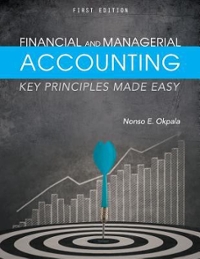Please go first through Chapter 4 Chapter 5, the case studies, and the answer to the problem analysis 1. A. SHORT QUESTIONS 1. What is the internal rate of return? 2. What is the difference between real and nominal interest rates? 3. What is risk and how to measure it? 4. What is the difference between idiosyncratic and systematic risk? 5. What is hedging? 6. Explain how diversification can be used to reduce risk. B. ANALYTICAL QUESTIONS QUESTION 1 Consider two investment alternatives, investment I and investment II, with their payoffs and their associated probabilities outlined in the following table: Investment Payoff Probability 20 0.10 5 0.20 10 0.70 Investment II Payoff Probability 5 0.20 10 0.30 4 0.50 1. Compute the expected value for investment I and investment II; 2. Compute the variance for investment I and investment II; 3. Compute the standard deviation for investment I and investment II; 4. Compute the Return-Risk Index (RRI) for investment I and investment II; 5. Would you select investment I or investment II? Why? QUESTION 2 Assume you place $5000 in a saving account paying 4% a year. How much would you have in this saving account in 3 years? QUESTIONS Find the monthly payment needed to repay a 3-year car loan of $7,000 when the interest rate is 2%, compounded monthly. QURSTION 4 John expects to receive $2,000 in 2024. Calculate the present value of this cash flow assuming an interest rate of 6%, compounded annually. QUESTION 3 Mike invested $3000 in IBM paying 6% interest rate a year. Using the rule 72, how long will it take to double Mike's investment? QUESTION 6 Suppose you invested $4000. The expected payoffs are provided in the following table: Case Scenario Payoff 1 $4500 2 $3800 3 $4700 What is the value at risk? Hint: compute the return for each case scenario (return - Payoff - Initial Investment). Please go first through Chapter 4 Chapter 5, the case studies, and the answer to the problem analysis 1. A. SHORT QUESTIONS 1. What is the internal rate of return? 2. What is the difference between real and nominal interest rates? 3. What is risk and how to measure it? 4. What is the difference between idiosyncratic and systematic risk? 5. What is hedging? 6. Explain how diversification can be used to reduce risk. B. ANALYTICAL QUESTIONS QUESTION 1 Consider two investment alternatives, investment I and investment II, with their payoffs and their associated probabilities outlined in the following table: Investment Payoff Probability 20 0.10 5 0.20 10 0.70 Investment II Payoff Probability 5 0.20 10 0.30 4 0.50 1. Compute the expected value for investment I and investment II; 2. Compute the variance for investment I and investment II; 3. Compute the standard deviation for investment I and investment II; 4. Compute the Return-Risk Index (RRI) for investment I and investment II; 5. Would you select investment I or investment II? Why? QUESTION 2 Assume you place $5000 in a saving account paying 4% a year. How much would you have in this saving account in 3 years? QUESTIONS Find the monthly payment needed to repay a 3-year car loan of $7,000 when the interest rate is 2%, compounded monthly. QURSTION 4 John expects to receive $2,000 in 2024. Calculate the present value of this cash flow assuming an interest rate of 6%, compounded annually. QUESTION 3 Mike invested $3000 in IBM paying 6% interest rate a year. Using the rule 72, how long will it take to double Mike's investment? QUESTION 6 Suppose you invested $4000. The expected payoffs are provided in the following table: Case Scenario Payoff 1 $4500 2 $3800 3 $4700 What is the value at risk? Hint: compute the return for each case scenario (return - Payoff - Initial Investment)








